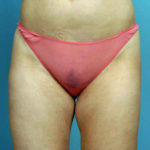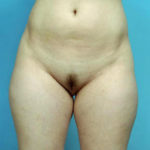A person will lose weight immediately following liposuction.
A person will actually weigh more during the first 2-3 weeks following the procedure. That is due to fluid retention that often takes days or weeks to completely subside. However, the full reshaping effects of the procedure will not be fully noticed until 2 to 3 months post-op, as it takes this long for swelling to completely go away and the skin to shrink down and adapt to the reduced fat layer.
Liposuction will cause loose hanging folds of skin to shrink and disappear.
While minor amounts of skin may shrink, removing fat (deflating the balloon so to speak) will usually leave more loose skin rather than less. This is particularly true of abdominal skin in women where all elasticity may be lost from prior pregnancies. Skin excision procedures are occasionally necessary later to remove excess skin. This can usually be determined prior to liposuction.
Liposuction improves or can get rid of cellulite
Contrary to popular belief, cellulite is not the result of being overweight. It is a structural abnormality of the fat that is much more common in women. Liposuction removes fat but not the damaged fat immediately under the skin that causes the appearance of cellulite. If too much fat is removed during liposuction, it may make the appearance of cellulite worse. This is a particular issue in the thighs where the common occurrence of cellulite and the performance of liposuction cross.
Liposuction helps get rid of stretch marks.
Similar to cellulite, liposuction may make stretch marks more noticeable afterwards. Stretch marks are caused by incomplete tears on the underside of the skin which also means there is no elasticity left. Therefore, areas that have many stretch marks will not tighten up after liposuction.
One should try and suction off as much fat as possible
While good effort should be expended to remove fat with liposuction, the goal is to not remove as much as possible. Such an approach will lead to irregularities, an unnatural look and skin contractures to underlying tissues, Some fat must remain between the skin and the muscles for it to look and feel natural. Like sculpting a marble statue, it is not important what is on the floor but what is left on the remaining block of marble which determines a good result. Contour changes are the goal of liposuction, not maximal fat removal.
Once fat is removed by liposuction, it is gone forever.

Liposuction causes more fat to go to non-treated areas of the body if one gains weight
With significant weight gain, fat is going to go somewhere. But it is not always predictable in anyone as to where it will go. For some, it may come back from where it was removed. In others, it may go elsewhere. Stomach and waistline areas are particularly prone to recurrence with weight gain as that is a primary fat depot site for both men and women.
Having fat removed by liposuction can improve your health
While it is not debated that it health is improved with lower percentages of body fat, the amount of fat removal for most patients will not make a substantial improvement in reducing cholesterol levels, insulin requirements, or the risk of heart disease. Liposuction, in combination with other lifestyle changes and weight loss, can lead to such improvements.
Dr. Barry Eppley
Indianapolis, Indiana



